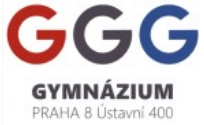Czechia, by official name The Czech Republic (with population about 10 mil.), is a state in Central Europe right next to Germany, Poland, Slovakia and Austria.
The Czech Republic is divided into 3 parts: Bohemia, Moravia and Czech Silesia and it covers an area of approximately 76,000 Km2.
The capital (and the largest city) is Prague (about 1 mil. residents).
National Symbols
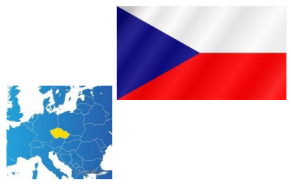 The Statue of St. Wenceslas on the Wenceslas Square.
The Statue of St. Wenceslas on the Wenceslas Square.
Crown Jewels
National Flag of Czechia
Location of Czechia in Europe
Historical sights and natural beauty
In Prague: National Museum, Charles Bridge, Prague Castle (the biggest castle complex in the world), St. Vitus Cathedral, Prague astronomical clock, Petřín (Czech Eiffel Tower).
National Parks: NP Šumava, NP Podyjí, NP Czech Switzerland and Krkonoše NP.
The Highest Mountain: Sněžka (1603 m.)

About Prague
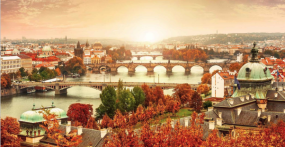 Prague (in Czech: Praha) is the capital and the largest city of the Czech Republic. It’s situated on the Vltava river in the north-west part of the country. The population of the capital is about 1.3 million. Many famous moviemakers choose to shoot their films in Prague
Prague (in Czech: Praha) is the capital and the largest city of the Czech Republic. It’s situated on the Vltava river in the north-west part of the country. The population of the capital is about 1.3 million. Many famous moviemakers choose to shoot their films in Prague
because of its scenic views and historical atmosphere.
History
Founded in the 7th century, Prague had been a political, cultural and economic centre of central Europe for many centuries. It was the main residence of several Holy Roman Emperors and played an important role during the Thirty Years’ War, the Bohemian and Protestant Reformation.
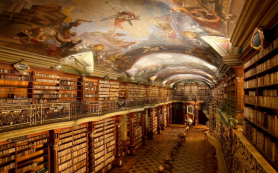 The city‘s greatest flourishment came in the 14th century during the reign of Charles IV., King of Bohemia and Holy Roman Emperor. He ordered the construction of many important Prague monuments and institutions, e.g. the Charles Bridge, the Gothic Saint Vitus Cathedral, … He also founded Charles University which is known for being the oldest university in central Europe and ranks among the best in the whole world. The Clementinum is considered one of the most beautiful libraries.
The city‘s greatest flourishment came in the 14th century during the reign of Charles IV., King of Bohemia and Holy Roman Emperor. He ordered the construction of many important Prague monuments and institutions, e.g. the Charles Bridge, the Gothic Saint Vitus Cathedral, … He also founded Charles University which is known for being the oldest university in central Europe and ranks among the best in the whole world. The Clementinum is considered one of the most beautiful libraries.
Since 16th century the whole country had been under the control of the House of Habsburg, but Czech people fought many times during this reign to get out of this domination. In the 19th century the Czech National Revival began its rise. The Czech language started to get more and more important again.
20th century created big changes for Bohemia. With the defeat of the Austro-Hungarian Empire in the World War I, the creation of a new independent country called Czechoslovakia became possible. The country’s first president was Tomáš Garrigue Masaryk.
During the Second World War, Hitler envaded Prague and deported or killed a major part of its Jewish population. In 1945 on 5 May, two days before the capitulation of Germany, a bloody uprising against Germany occurred.
Thousands of Czechs were killed within those four days of street fighting and Germany capitulated. On 9 May the Red Army took the city and Prague became controlled by the Soviet Union and the Communist regime began.
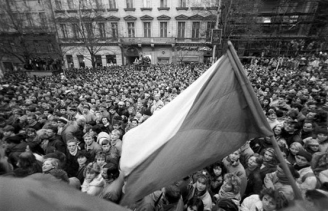 After many demonstration and attempts at reformation, finally in 1989 the Velvet Revolution crowded the streets of Prague and soon after that the Communist Party capitulated.
After many demonstration and attempts at reformation, finally in 1989 the Velvet Revolution crowded the streets of Prague and soon after that the Communist Party capitulated.
The Czech Republic was created in 1993 after the split of Czechoslovakia and Prague became its capital city. The first president was Václav Havel.
Historical monuments and parts of Prague
The Petrin hill
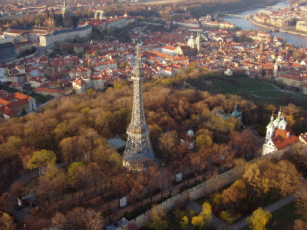 It is a 327 meters high hill in the middle of Prague. There is a lookout tower on the top. Its name comes from a Latin word petra, wich means stone or rock. The chronicler Kosmas described Petrin as a very rocky place. From 1108 to 1360 this place was used as an execution site.
It is a 327 meters high hill in the middle of Prague. There is a lookout tower on the top. Its name comes from a Latin word petra, wich means stone or rock. The chronicler Kosmas described Petrin as a very rocky place. From 1108 to 1360 this place was used as an execution site.
Then Charles IV. built a Hungry wall and he connected Petrin to the rest of Prague. Today it’s a touristic and cultural place with many constructions to visit, like the lookout tower, the labyrinth of mirrors or the church of Saint Vavřinec.
The National museum
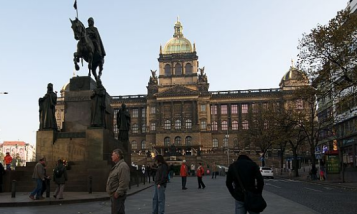 The largest and oldest Czech museum is situated in a Neo-Renaissance building dominating the Wenceslas Square, a UNESCO World Heritage Site. Besides the pantheon of the Czech nation, there is a prehistoric, historical-archaeological, theatrical, mineralogical, geological-paleontological and zoological collection. The museum organizes numerous cultural events and exhibitions. The impressive building is the pride of the New Town and one of the main landmarks of Prague.
The largest and oldest Czech museum is situated in a Neo-Renaissance building dominating the Wenceslas Square, a UNESCO World Heritage Site. Besides the pantheon of the Czech nation, there is a prehistoric, historical-archaeological, theatrical, mineralogical, geological-paleontological and zoological collection. The museum organizes numerous cultural events and exhibitions. The impressive building is the pride of the New Town and one of the main landmarks of Prague.
The National Theater
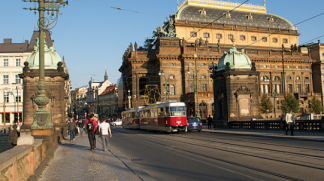 The Neo-Renaissance building of the National Theater was built in 1868-1881 according to the design of the architect Josef Zítek. Shortly after the ceremonial opening, however, there was a devastating fire that seriously damaged the building that was almost completed before. Thanks to the generous financial donations of many culturally conscious Czechs, the National Theater building was rebuilt after renovation and completion in 1883. The reconstruction was carried out by architect Josef Schulz, the exterior and interior decoration was made by artists of the so-called generation of the National Theater – Mikoláš Aleš, František Ženíšek, Vojtěch Hynais and Josef Vaclav Myslbek. Bedřich Smetana composed the opera Libuše for the ceremonial reopening.
The Neo-Renaissance building of the National Theater was built in 1868-1881 according to the design of the architect Josef Zítek. Shortly after the ceremonial opening, however, there was a devastating fire that seriously damaged the building that was almost completed before. Thanks to the generous financial donations of many culturally conscious Czechs, the National Theater building was rebuilt after renovation and completion in 1883. The reconstruction was carried out by architect Josef Schulz, the exterior and interior decoration was made by artists of the so-called generation of the National Theater – Mikoláš Aleš, František Ženíšek, Vojtěch Hynais and Josef Vaclav Myslbek. Bedřich Smetana composed the opera Libuše for the ceremonial reopening.
The Old Town
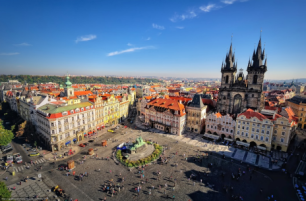 The Old Town (Czech: Staré Město) is a medieval settlement of Prague. Notable places in the Old Town include Old Town Square and Astronomical Clock. The Old Town is surrounded by the New Town of Prague. Across the river Vltava connected by the Charles Bridge is the Lesser Town of Prague (in Czech: Malá Strana). The former Jewish Town (Josefov) is located in the northwest corner of Old Town heading towards the Vltava.
The Old Town (Czech: Staré Město) is a medieval settlement of Prague. Notable places in the Old Town include Old Town Square and Astronomical Clock. The Old Town is surrounded by the New Town of Prague. Across the river Vltava connected by the Charles Bridge is the Lesser Town of Prague (in Czech: Malá Strana). The former Jewish Town (Josefov) is located in the northwest corner of Old Town heading towards the Vltava.
The Astronomical Clock
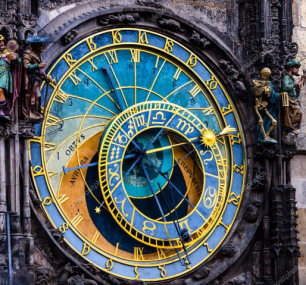 The astronomical clock (Orloj) is mounted on the southern wall of Old Town Hall in the Old Town Square. The clock mechanism itself has three main components: the astronomical dial, representing the position of the Sun and the Moon in the sky and displaying various astronomical details, statues of various Catholic saints stand on either side of the clock, “The Walk of the Apostles”, a clockwork hourly show of figures of the Apostles and other moving sculptures – notably a figure of Death (represented by a skeleton) striking the time and a calendar dial with medallions representing the months. According to the local legend, the city will suffer if the clock is neglected and its good operation is placed in jeopardy. A ghost, mounted on the clock, was supposed to nod its head in confirmation. According to the legend, the only hope was represented by a boy born on New Year’s night.
The astronomical clock (Orloj) is mounted on the southern wall of Old Town Hall in the Old Town Square. The clock mechanism itself has three main components: the astronomical dial, representing the position of the Sun and the Moon in the sky and displaying various astronomical details, statues of various Catholic saints stand on either side of the clock, “The Walk of the Apostles”, a clockwork hourly show of figures of the Apostles and other moving sculptures – notably a figure of Death (represented by a skeleton) striking the time and a calendar dial with medallions representing the months. According to the local legend, the city will suffer if the clock is neglected and its good operation is placed in jeopardy. A ghost, mounted on the clock, was supposed to nod its head in confirmation. According to the legend, the only hope was represented by a boy born on New Year’s night.
GRAMMAR SCHOOL ÚSTAVNÍ
Basic facts
The grammar school Ústavní is located in Prague 8, in Bohnice district. It was founded in 1990 by The Czech Republic as a generally focused Czech grammar school. One year later the Italian educational programme was opened too. Our school is one of the most prestigious in Prague.
Famous teachers
Our school is also known and famous thanks to our teachers. The most famous is Eva Farfánová Barriosová, who was an archeologist in Peru, South America, and now she is teaching us the Spanish language. Our Czech teacher Josef Soukal is known as a writer of literature textbooks for high schools. In our school there is also Stanislav Mistr, a brilliant musician, who plays almost all instruments (piano, violin, trumpet, flute, guitar, drums, ukulele, boombackers, violoncello…). He’s a famous composer and conductor, his famous song is a pop version of Czech Christmas Mass (original: Jakub Jan Ryba).
Interesting facts
Every year our school prom is held in one of the most prestigious and beautiful places, in Lucerna great hall. Every year students also prepare Christmas show, which is played in Theatre behind the fence. We have school EKOtým (ECOteam) too. EKOtým is group of students, who take care of flowers, ecology in school and others things, which help the environment.
Equipment
Grammar school Ústavní has 2 floors, where’re 22 classrooms, 2 computer classrooms and 3 laboratories. We also have an atrium with 4 ping-pong tables, 2 gyms, gymnastic hall and one playground for PE. At the moment there’re construction works for roof in atrium and soon we’ll be allowed to have lessons on fresh air.
Achievements
Our school often takes part in competitions in different subjets, for example in Maths, Physics, Chemistry, PE, Geography, Czech and foreign languages and others. We’re very successful in all of them, our students often take first places. Our teachers always support us!
It’s very hard to pass entrance exams to our school, and we are happy, that we’re studying here. This year there are about 650 students and 54 teachers.

